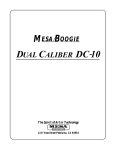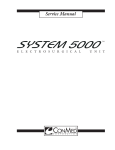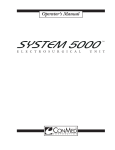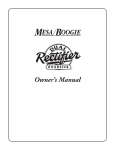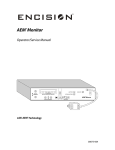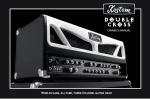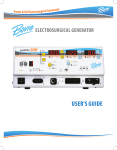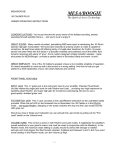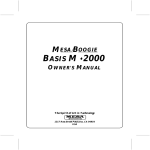Download Studio Preamp Owners Manual
Transcript
MESA/BOOGIE The Spirit of Art in Technology Studio Preamp Owner’s Manual Studio Preamp Owner’s Manual Congratulations on your purchase of the MESA/Boogie Studio Preamp! In this compact, rack-ready package you’ll find all the basic tones that made Boogie famous – clean, warm, smooth rhythm sounds; a screaming, vicious Lead voice; and enough control to produce anything in between. The Preamp is simple and straightforward, yet sophisticated. Like all other Boogies, it’s based on a no compromise, all-tube circuit with traditional style tone controls and instant Lead/Rhythm footswitching. It includes a 5 band graphic EQ for tone customizing; a carefully tweaked, deep-sounding 3-spring reverb; a stereo effects loop that can accommodate either low-level or line-level effects; and two pairs of stereo outputs (including Recording Outputs with speaker-simulator circuitry, which will mate perfectly with either a mixing console or the front end input of most guitar amps.) NOTE: If you are using the Studio Preamp in conjunction with a "dedicated" power amp, we strongly recommend the use of a high quality, all tube amplifier such as our Stereo Simul-Class 295, or the Strategy 400. Only then can you be assured of taking full advantage of the Preamp’s sound quality. 1. Connecting the Preamp: The simplest method for connecting the Preamp is to plug your guitar into the front or rear panel INSTRUMENT INPUT, then run shielded cables from MAIN OUTPUTS A&B into the inputs of your power amp. The two output level controls on the Preamp will determine the overall level being sent to the power amp. (If you are feeding into a mono power amp, use either one of the Preamp’s Main Outputs A or B. If you wish to use the Preamp in conjunction with a "normal" guitar amplifier such as a Fender, Marshall, etc., you can either 1) run a shielded cable from one of the Preamp’s rear panel RECORDING OUTPUTS into the front panel input of the amp; or 2) run a cable from one of the MAIN OUTPUTS into the effects return or Power Amp Input jack of your amp (assuming your amp has one of these). If the Preamp is being used for recording and you wish to connect it directly to a mixing console, we recommend using the RECORDING OUTPUT(s), connected to a line level input on the console. Or, as an alternative, you can use one or both of the Preamp’s MAIN OUTPUTS for this purpose. The Recording Outs are EQ’d differently than the Main Outs, so the choice here is mainly a matter of taste. 2. Using Stereo Effects: The Studio Preamp is capable of stereo operation if used with a stereo effects unit (and, of course, a stereo power amp). To do this, connect a shielded cable from the Preamp’s EFFECTS SEND jack into the input of your effects unit, and set the Preamp’s EFFECTS LEVEL switch to either "LOW" (for using floor pedals or "inexpensive" rack effects) or "LINE" (for using studio-quality effects). Then connect the outputs of the effects unit to the RETURN jacks on the Preamp using shielded cables, and use the Preamp’s Main Outputs to feed the power amp. Use the Mix or Blend control on the effects unit to set the "wet/dry" (effect/direct) blend. Another way to run the Preamp in stereo with effects is to connect one of the Preamp’s MAIN OUTPUTS (or both, if the effects unit has stereo inputs to the input of the effect. In this case the Preamp’s OUTPUT LEVEL control(s) will determine the send level to the effects; the overall level going to the power amp will be determined at the effects unit. 3. The Controls: Let’s review the controls one at a time to learn their various functions and how they interact. Volume: This very powerful control determines the gain in the Rhythm mode and also the amount of signal fed to the lead mode. Lower settings of this control will result in cleaner, brighter rhythm sounds and lower gain lead sounds. Higher settings will result in fatter clean rhythm sounds and tighter, more focused lead tones. By experimenting with the volume control you will discover a "sweet spot", probably somewhere between 6 and 7 1/2, where you’ll find the ultimate shimmering warmth in your clean sound, yet enough gain to keep your lead mode tight and singing. We’ve found that settings of 6 3/4 to 7 provide a great clean sound and yet allow instant switching to a great lead sound. However, players who put emphasis on the ultimate clean sound will probably want to set the Volume at 5 1/2 to 6. If you never use clean sounds or don’t need "squeaky-clean" rhythm sounds you’ll probably be more concerned with the Lead mode. In that case a volume setting of 7 1/2 to 8 may be in order. Of course, the best way to find the setting that is "the ultimate" for you is simply to experiment. Master: This control serves two purposes and remains functional in both modes. It is a master volume control for the rhythm mode and it is also in series with Lead Master. This means that low settings of the Master control should be balanced with higher settings of the Lead Master control if equal levels are desired between Lead and Rhythm modes. Similarly, higher settings on the Master will require lower settings on the Lead Master to achieve a balance. A good basic setting for the Master control is 5. If you start around 5, you can still increase or decrease the setting to a degree without having to alter the Lead Master setting. The second purpose of the Master control is that it functions as the Effects Send level. Again a setting of 5 usually provides the right amount of signal to drive most effects units. If this setting is incompatible with your effects, adjust as needed and then re-adjust the overall loudness of the Preamp with the Output Level controls. Lead Drive: As you might expect, this control adjusts the gain, sustain and sensitivity of the Lead mode. Although it is affected by the setting of the Volume control, it has enough gain to produce anything from a "bluesy", slightly dirty tone to an insanely overdriven "metal" sound even at very low volumes. Touch sensitive! We’ve found that the best tones seem to occur with the Lead Drive set in either the 2-3 or the 5-6 regions. Treble: This control adds "highs" and "bite" to your tone. It also has the effect of adding gain and sustain to the Lead mode. Adjusting this control while switching between Lead and Rhythm modes, you’ll find a "sweet spot", probably somewhere between 6 and 8, which gives you the right amount of bite and penetration without sounding harsh. Lead Fat (Switch): This rocker switch "re-voices" the Treble control shifting it’s effective range downward to the upper mid-range zone. Affecting only the Lead mode, it adds fatness, gain and sustain to the tone. Bass: This powerful control adds roundness, warmth and bottom to the tone. Like the Treble control, it should be set with both modes in mind; high settings, which may sound great for rhythm, may sound "flabby" in lead. However, too little bass may leave you with a "flat", two-dimensional sound. Try setting this control between 3 and 5 for starters. Middle: This control is the least significant and easiest to use of the three tone controls. Although it’s action may not seem dramatic, it adds midrange warmth when used with relatively "normal" setting of the Treble and Bass controls. Rhythm Bright and Lead Bright (Switches): These switches accentuate the "super-top" or extreme high frequencies, adding shimmer and sparkle to the Rhythm mode and a "searing" quality in Lead. The Bright switches are most useful at low settings; at high gain settings they are usually unnecessary and may cause excessive noise or feedback. To avoid this, you should either reduce the Volume (and/or Lead Drive) slightly, or turn off the Bright switch when such extreme settings are desired. Graphic Equalizer: The Studio Preamp is equipped with an onboard graphic EQ that is specifically tailored for guitar. The center frequencies of each of it’s 5 bands were carefully selected as the ones most useful and effective for the instrument. What the graphic allows you to do is drastically reshape the tone structure or frequency response curve of the Preamp. The EQ comes "after" the rotary tone controls and distortion circuitry in the Preamp and is generally used to enhance the basic tone after you’ve set the rotaries. However, it can also be used to p-provide a separate set of "tone controls" for the Lead mode (see explanation of EQ AUTO below). Although the EQ adds tremendous flexibility to the Preamp, it is not necessary for achieving a good tone, and can be switched out of the circuit at any time. (All the tonal R&D that went into perfecting the Preamp’s sound was done with the EQ out). The front panel EQ Switch has three positions: EQ IN, EQ OUT (the unlabeled center position) and EQ AUTO. When the switch is set to EQ OUT, the EQ is not active but can still be switched in via the optional EQ footswitch. When the switch is set to EQ IN, the EQ is active (and cannot be footswitched off). In EQ AUTO, the EQ will automatically kick in whenever you are in the Lead mode, and will automatically switch off when you are in Rhythm. In this way, you can create a tone "preset" for Lead that is entirely different from your Rhythm tone. Although there are many useful EQ settings, on "graph" seems to have found its way onto every coliseum stage at one time or another: the classic "V"! This setting produces a dramatically "fat" sound by boosting the extreme lows and highs while cutting back the mids. Specifically, you move the two outside sliders (80 & 6600 Hz) to a setting just below the highest line. Then you position the 2nd and 4th sliders just above the centerline. Then take the 750 Hz slider, center it at the lower line, and fine-tune it. (You’ll find this region very responsive to even tiny adjustments - it’s like a pivot-point of the "V" sound.) Of course, the "V" is just one of the many possible EQ combinations. Like all the other controls, the EQ is there to help you find the tones that sound great to you. REVERB: The Studio Preamp includes a built-in 3-spring reverb unit. The reverb circuit has been painstakingly "tweaked" to eliminate any buzzing, "boinging" or clipping that sometimes occurs with springs. When the reverb control is set at zero, only the "dry" or non-reverberated signal is heard. As the control is turned up, the "wet" or reverberated signal is gradually mixed in. Try a setting of 3 for a "medium" amount of reverb, or "season to taste". Once you’ve got a setting you like, you can switch it in or out with the optional reverb footswitch (or other external switching) via the rear panel FUNCTION jack labeled REVERB. OUTPUT LEVEL (A & B): This pair of controls determines the overall level being sent form Main Outs A & B (and Recording Outs A & B) to your power amp (or mixing console). To get the best signal-to-noise ratio and to avoid clipping, the levels must be set neither too low nor too high. If you need guidance in setting these levels, try the following method: Start by setting both Output controls to zero. Next, set the Master control at "5" and the Lead Master at "4". Set the Lead Drive at "6" and the Volume at "7". With these settings, the volume levels of the Rhythm and Lead Modes will be about equal. Now we are ready to bring up the Outputs. With the Power and Standby switches in the Preamp and power amp in the "ON" position, slowly bring up OUTPUT LEVEL A to the desired listening level. (Depending on the power amp being used, the setting will most likely be very low, probably between 2 and 4). Next, increase OUTPUT LEVEL B until its level equals that of OUTPUT A. (Don’t be surprised if the number settings on the two outputs are slightly different when equal levels are attained. This sometimes occurs because of slight variances in the resistor values of the potentiometers.) If effects are in use in the Effects Loop and the effects send level seems too high or low, try adjusting the INPUT LEVEL or HEADROOM control on the effect device first, if the level is still not optimum, adjust the Preamp’s Master and Lead Master controls as needed, and then re-adjust the OUTPUT LEVEL controls to compensate. POWER SWITCH (and Pilot Light): This is the AC Power On/Off switch for the Preamp. When its pilot lamp is lit, it indicates that AC voltage is being supplied to the Preamp. STANDBY SWITCH: The Standby Switch shuts off the signal at the effects send stage. When the Preamp is in Standby mode, any noise produced by devices in the effects loop will be audible (but the signal "content will not be). If this noise is objectionable or undesirable, use the Standby switches on your power amp to must the noise. We recommend switching the Preamp into its Standby mode 1) during "power-up (leave in standby for about 30 seconds); 2) while patching in instruments and effects; 3) during set breaks at gigs or rehearsals; and 4) before "powering down". MODE/EQ LED INDICATORS: These three red LEDS (located under the tone controls) indicate whether you are in the Rhythm or Lead mode, and whether the EQ is active or not. 4. REAR PANEL CONNECTIONS INPUT: This 1/4" jack is one of two possible inputs that can be chosen; the other input location is on the front panel. The front panel input and rear panel input are identical in function and the choice is simply one of convenience. The input jacks are insulated mono jacks designed to handle one instrument. (We don’t recommend using both of them at once.) Always use a high-quality shielded cable to connect your instrument to the Preamp. LEAD/RHYTHM FOOTSWITCH: This jack will accept either the Lead/Rhythm footswitch included with your Preamp (or any standard grounding-type footswitch) or connections from an external switching system such as MESA/Boogie MIDI Matrix. It allows remote switching between Lead and Rhythm modes. FUNCTION SWITCHES (Reverb, EQ & REV, EQ): These 1/4" jacks are used to control the Reverb and/or the EQ functions using the optional footswitches. For controlling the Reverb alone or the EQ alone, connect our Single Footswitch to the appropriate jack using a 2-conductor unshielded cable. If you’re using the Dual Footswitch to control both reverb and EQ, plug it into the center (EQ & REV) jack using a 3-conductor (stereo) cable. The function jacks can also be used to control the reverb and EQ from an external switching system such as the MIDI Matrix. EFFECTS LOOP: The Effects Loop in the Preamp has a mono (single) send and stereo (dual) returns. This means you can incorporate stereo effects devices in the loop and the signal will be maintained in full stereo all the way through to the outputs. The Effects Loop Level switch should be set according to the type of effects you are using. For floor pedals (and some "inexpensive" rack effects) select the "LOW" position. When "studio-quality" or line0level effects are in use, select the "LINE" position. If your effects device also has a switch of this kind, make sure the settings of both switches coincide. MAIN OUTPUTS: This pair of 1/4" jacks is intended primarily for connecting the Preamp to a power amp. Its output level is determined by the OUTPUT LEVEL controls on the front panel. If you are using some type of stereo effect in the Preamp’s Effects Loop, then the Main Outs function as a stereo pair. If you’re not using a stereo effect, they function simply as two mono outs (in other words, the content of Main Output A will be the same as the content of Main Output B). If you’re operating the Preamp in mono and you are feeding into a mono or single power amp input you can use either Output A or Output B - it makes no difference. RECORDING OUTPUTS: This pair of outputs (also 1/4" jacks) has been specially EQ’d and buffered to simulate the sound of a power amp loaded by speakers, for use in "direct inject" recording situations when the Preamp is plugged directly into a mixing console. Like the Main Outs, the Recording Outs function as either a stereo pair or as two mono outputs (depending on whether you’ve got a "stereo-izing" device in the Effects Loop or not) at levels determined by the front panel OUTPUT LEVEL controls. USING THE PREAMP AS AN "EFFECT BOX": Another excellent use for the Recording Outputs is for connecting the Preamp to the input of a normal guitar amplifier such as a Fender, Marshall, etc. The Preamp then becomes a super "effect box", adding Tone, Gain, Footswitching, Distortion, EQ, Reverb, and en Effects Loop to the normal capabilities of your amplifier! The Recording Outs can be connected straight into the front panel input of the amp (there’s no need to attempt to bypass the amp’s preamp section) and should not require any radical alteration of your normal amp settings. LINE FUSE: A 1 1/4 amp fuse protects The Studio Preamp when operating on 100-120 V. AC. Should the fuse blow, replace it with a Slo-Blo fuse of the same amperage. LINE CORD: This is a standard 3-pin AC line cord. A ground-lifting (3 to 2) adapter may be found useful in eliminating hum cased by grounds loops when the Preamp is connected to a power amp. (This problem would not tend to arise when running into a mixing console). GROUND ISOLATION SWITCH: This mini-rocker switch is extremely useful in reducing the hum and buzz caused by ground loops which occur in rack installations. Ground loops occur when there is more than one path for grounds between electronic units. There are three main type of ground loops: each one contributes its own trademark component of buzz or hum. The three types of ground loops are: 1) Grounds are connected via the ground lugs of the power cords on the units. The rule-of-thumb here is that one and only one unit in a rack should have a connection to the AC power ground; all the other units in the rack should have their grounds lifted by using 3-to-2 adapters on their AC plugs. 2) Ground loops occurring because of two or more audio cables connecting two components. The most common solution is to disconnect the shield from the sleeve connection at one end of some of the inter-connecting cables, so that only one cable between each device has an intact ground shield. Some experimentation is required to find which cable is best for conducting the ground, and which cables are best suited to have the special "clipped ground". We recommend trying the intact-ground cables for the signal path which flows, say, from the Preamp’s Effects Send to an effects unit; and trying the clipped-ground method on the cable which connects the effects output back into the Effect Return on the Preamp. 3) Ground loops created by the physical contact between the metal chassis of the components and the steel rack rails. It is for this third type of ground loop that the Ground Isolation Switch was provided. The switch effectively lifts the electronic circuit ground from the metal chassis ground (which otherwise must be done manually by disconnecting a wire inside of the Preamp). Here again, the rule is that one device in your system - and usually only one - needs its circuit ground connected to its metal chassis ground; all others should be lifted (in other words, disconnected) for quietest operation. (Some effects units provide similar switches; some are constructed such that the input ground and the output grounds are permanently separated; in other cases, the method used to isolate the grounds is unclear). Again, some experimentation is vital to discovering which combination of "lifted" and "grounded" works best in your rack....and out Ground Isolation Switch makes it much easier. NOTE: If the Studio Preamp is operated outside of a rack installation, the switch should generally be set to the Normal position, or else squealing, buzzing and oscillation may occur. Always check this switch before thinking that something has gone wrong with your Preamp!! Studio Preamp Sample Settings Some dual-mode settings: 8 Blues 5 6 Volume Master Treble 3 5 Bass Mid 3 3 Bass Mid 6 7 Bass Mid 3 5 Bass Mid Clean Rhythm, Sweet Lead OFF Rhythm Bright 6 Rock OFF Lead Bright 6 6 Clean Rhythm, Rock Lead 10 Metal ON Lead Bright 3 10 Chunky Rhythm, Searing Lead 5 Fusion OFF Lead Bright 7 5 Sparkling Rhythm, Articulate Lead OFF Lead Bright Lead Lead Reverb Drive Master 5 1.5 3 Lead Lead Reverb Drive Master 3 4 2 Lead Lead Reverb Drive Master ON Lead Fat Volume Master Treble OFF Rhythm Bright 3 ON Lead Fat Volume Master Treble OFF Rhythm Bright 3 OFF Lead Fat Volume Master Treble ON Rhythm Bright 2 ON Lead Fat 5 2 3 Lead Lead Reverb Drive Master Studio Preamp Sample Settings 5 Country 6 7 Volume Master Treble 3 5 Bass Mid Clean Rhythm, Silky Lead OFF Rhythm Bright OFF Lead Bright 2 4 3 Lead Lead Reverb Drive Master OFF Lead Fat Here are some settings optimized for Rhythm or Lead mode: 5 Shimmering Rhythm 3.5 5.5 (Lead Mode) OFF Lead Bright 5 ON Lead Bright 5.5 4 ON Lead Bright 5 Bass Mid 5.5 4 Bass Mid 5.5 4 Bass Mid - - 3.5 Lead Lead Reverb Drive Master 2.5 4 3 Lead Lead Reverb Drive Master OFF Lead Fat 8 Volume Master Treble OFF Rhythm Bright 4.5 OFF Lead Fat Volume Master Treble OFF Rhythm Bright Crunch Chords 6.5 Volume Master Treble ON Rhythm Bright Blues Lead 4.5 ON Lead Fat 4.5 3.5 3 Lead Lead Reverb Drive Master Studio Preamp Sample Settings 6.5 Metal Lead 4 8 Volume Master Treble 5 5 Bass Mid 4 5 Bass Mid Lead Lead Reverb Drive Master Bass Mid Lead Lead Reverb Drive Master Bass Mid Lead Lead Reverb Drive Master (Use “V” Graph EQ) OFF Rhythm Bright 5 JAZZ ON Lead Bright 6 0 (Rhythm Mode) OFF Lead Bright Lead Bright Lead Bright Lead Lead Reverb Drive Master - - 3 Lead Fat Volume Master Treble Rhythm Bright 3 OFF Lead Fat Volume Master Treble Rhythm Bright 3 ON Lead Fat Volume Master Treble ON Rhythm Bright 6 Lead Fat MESA/BOOGIE The Spirit of Art in Technology












